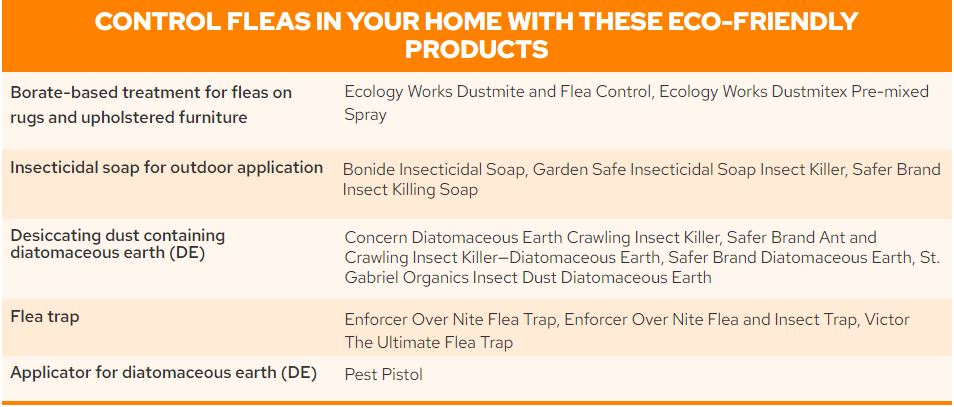
Learn how to control fleas with these tips from the City of Goleta Environmental Services Division.
Did You Know?
Fleas make pets and people uncomfortable and can transmit tapeworms to pets and sometimes to children.
It takes about 18 days for a flea egg to grow into an adult flea, but in temperatures above 37 ̊F, fleas can be dormant for up to 18 months. A flea lays 20 to 50 eggs each day, so flea problems in your home can get out of control quickly, especially in warm weather. Adult fleas can live on your pet for 30 to 40 days—and they generally account for only 5 percent of fleas (counting fleas in all stages of their life cycle) in your home!
Finding Fleas in the Home
Adult fleas spend almost all of their time on an animal’s body. If you haven’t seen fleas but your dog or cat is scratching, your pet may have fleas.
You may be able to see tiny white flea eggs and white, worm-like flea larvae on the floor, in cracks and crevices, in carpets, and where pets rest or sleep. You may also see “flea dirt” (flea droppings) where your pet sleeps. These black specks contain blood and turn red when wet.
What Can I Do?
Fleas In Your Home
- Because fleas in many life stages live in your home and not on your pet, thorough vacuuming and washing your pet’s bedding is a key part of your flea control program.
- Vacuum carpets, floors, couches, and chairs often to pick up adult fleas, larvae, and eggs. Empty vacuum or dispose of bags in the trash, outdoors.
- Wash pet bedding in hot soapy water every week.
- Thoroughly clean cracks and crevices in floors or baseboards, or seal permanently with caulk.
- Use a non-toxic flea trap to attract fleas and trap them on sticky paper. Traps work better if people and pets are not around—fleas prefer warm bodies to traps.
- Use diatomaceous earth (DE) to treat carpets, chairs, couches, and pet bedding. Use a hand duster to apply a thin layer of DE (labeled for use on pests, or use “food-grade” DE if you have small children) and blow it into cracks and crevices. Wear a dust mask and goggles to keep DE out of your lungs and eyes!
- When you treat furniture or carpets to kill fleas, use a borate-based solution, which can control fleas for up to a year.
Outside Your Home
- Don’t treat for fleas outdoors unless you know you have a major problem there.
- Do not try to combat fleas by spraying around the perimeter of your house or spraying your entire yard. Spot-treat with insecticidal soap only those areas where you find large populations of fleas.
- Apply beneficial nematodes (Heterorhabditis bacteriophora or Stienernema carpocapse) to soil where you have found fleas. You can buy them at garden centers or order online. Soil temperature must be between 60 ̊F and 90 ̊F, and the soil should be moist. Water before and after application, but don’t soak the area.

Fleas On Your Pet
- Wash your pet with pet shampoo and warm water. Using a flea comb while your pet is lathered should get rid of most adult fleas on him or her.
- Use a flea comb (available at pet stores) often to catch fleas crawling on your cat or dog. Drown fleas caught in the comb in a cup of warm soapy water and flush or pour down the drain. Make sure to comb well around your pet’s neck and base of the tail.
- Use chewable flea medication for your pet. Be sure you use the right dose for your type of pet (dog or cat) and his or her weight.
- Using flea medications in pill form protects water quality. Wastewater treatment plants cannot fully remove complex chemicals like pesticides. Wastewater agencies are concerned that pesticides in spot-on flea treatments can wash off a pet even weeks after being applied. In fact, these pesticides are turning up in wastewater treatment plant discharge and recycled water.
Find more information on controlling fleas with eco-friendly products in our OWOW brochures in English and Spanish.
The City of Goleta along with the Cities of Buellton, Carpinteria, Solvang, Santa Barbara, Santa Maria and the County of Santa Barbara have partnered with the OWOW organization to promote the use of less-toxic products in an effort to reduce pesticide pollution in our communities. By reducing pesticide use and the use of less-toxic products around the home, you can help reduce pesticides and other pollutants such as herbicides and fertilizers from being picked up while watering or when it rains and transported to the nearest storm drain inlet and into our waterways. The OWOW website is a great resource for finding less-toxic products to use around your home or garden.

